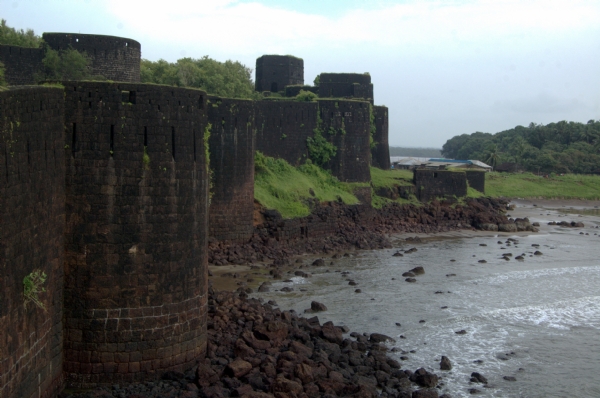Constructing Multiple Naval Bases, Warships Along The Maharashtra Coast
Shivaji Maharaj undertook the task of constructing multiple naval bases along the Maharashtra coast. He organized two fleets. While the majority of the Maratha Navy consisted of native Konkani sailors, it had few Siddis and Portuguese individuals. By 1659, the Maratha Navy possessed around 20 warships. The Marathas employed Portuguese naval officer Rui Leitão Viegas, aiming to gain insights into Portuguese naval technology and capabilities, as the Portuguese were known to possess a powerful navy. Portuguese later allied with the Marathas in their war against the Mughal Sultanate.

Vijaydurg: Located in present-day Maharashtra, Vijaydurg served as a crucial naval base for Shivaji Maharaj. He extensively fortified this coastal stronghold and developed it into a major naval center. The fort was positioned, providing control over the Arabian Sea and facilitating maritime trade and defense operations.
Sindhudurg: Built on an island off the Maharashtra coast, Sindhudurg was another important naval base . This fort was constructed with the primary purpose of safeguarding the coastline and serving as a base for naval operations. The fort's location ensured control over sea routes and acted as a deterrent to enemy navies.
Suvarnadurg: Situated near Harnai in Maharashtra, Suvarnadurg was another key naval base built by Shivaji Maharaj. This fort was positioned to protect the trade routes along the Konkan coast and serve as a base for naval activities. It provided a stronghold for the Maratha Navy and played a role in coastal defense.
Kolaba: Located in Alibag, Maharashtra, Kolaba was an essential naval base established by Shivaji Maharaj. This fortification served as a outpost, overseeing maritime activities and providing a safe harbor for Maratha warships. Kolaba played a role in protecting the coast and facilitating naval operations.
Dockyards: The naval bases were equipped with dockyards where ships could be repaired, maintained, and constructed. These dockyards had the necessary infrastructure, tools, and resources to handle the various needs of the Maratha Navy.
Shipbuilding Facilities: Shivaji Maharaj established shipyards within or near the naval bases. These shipyards were equipped with the necessary tools, workshops, and manpower to construct warships and other vessels. Skilled artisans and craftsmen were employed to build and maintain the ships.
Storage Facilities: The naval bases had storage facilities to house essential supplies, ammunition, and provisions for the navy. These storage depots ensured a steady supply of resources and facilitated efficient naval operations.
Living Quarters: To accommodate the sailors, officers, and support staff, the naval bases had living quarters within the fortifications. Barracks and residential areas were built to provide suitable accommodation for the naval personnel stationed at these bases.
Coastal Fortifications: The naval bases themselves were fortified with walls, bastions, and defensive structures to protect against enemy attacks. These fortifications provided a stronghold for the Maratha Navy and acted as a deterrent to enemy navies.
The ships were regularly inspected, repaired, and cleaned. Skilled craftsmen, such as shipbuilders and carpenters, were employed to ensure that the vessels remained seaworthy. Regular maintenance tasks included repairing hull damage, replacing rigging and sails, and preserving the wood using tar and other protective materials.
Conclusion
With great determination, Shivaji Maharaj oversaw the establishment of multiple naval bases along the coast of present-day Maharashtra, organizing them into two fleets. The strength of Shivaji Maharaj's Navy was substantial, boasting a formidable fleet of over 500 ships by the time of his demise in 1680, solidifying its position as a dominant force on the western coast line of India.
The Maratha Navy proved to be a versatile and multifaceted entity. It served a multitude of purposes, including safeguarding the coastline from potential invasions, imposing blockades on enemy ports, facilitating the transportation of troops and supplies, and executing raids on adversary shipping.
"The Maratha Navy, led by Shivaji Maharaj, disrupted the traditional balance of power at sea, forcing European powers to acknowledge their presence and adapt their strategies accordingly.
--

No comments:
Post a Comment